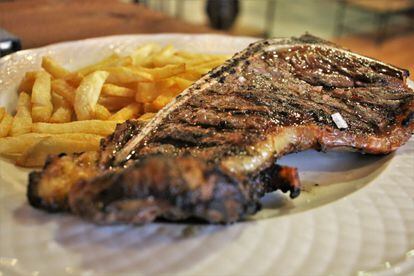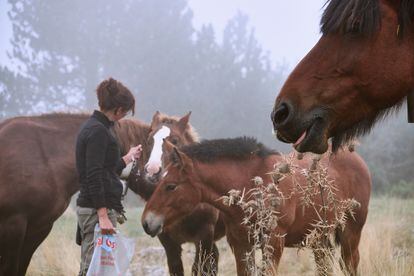Our food choices are neither free nor arbitrary. Each town has resolved its nutritional needs by adapting to the resources of the ecosystem it inhabits. But food is not just a physiological issue: it is a complex system of sociocultural beliefs that conditions what the table shows. Therefore, to understand the low consumption of horse meat in Spain we have to delve into this cultural imaginary forged over the centuries.
In the Paleolithic, men chased wild herds of horses. They were hunted and represented, but their domestication was complicated due to the animal's own character and the enormous expense involved in feeding it (a horse eats 30% more grass than a ruminant). Strong, noble and energetic, horses were therefore relegated to agricultural tasks since the first and populous civilizations of Asia and the Middle East. The horse and the plow formed a perfect symbiosis. But raising a couple of horses as a draft or transport animal made sense, raising large numbers did not. Except in the Asian steppes, endless grassy plains where nomadic shepherds like the Scythians survived on mare meat and milk. The Greek historian Herodotus, in the 5th century BC, recounts the way of life of this “barbarian” (foreign) people that the classical world considered uncivilized due to their detachment from agriculture, the basis of the diet of Classical Greece and Rome. . In the contempt of him, he counts Massimo Montanari in the book Food History, The fact of practicing ritual anthropophagy also intervened. However, both Greeks and Romans began to import horses from their nomadic neighbors to adapt them to their own needs. In the last years of the Roman Empire it was said that the Mongols survived long journeys by sucking the blood of their horses and that the Huns rode before walking, so the hosts that threatened Rome's border with the Danube were feared. In no Roman banquet, where you could taste a flamingo or a bear, was there ever a horse.
For the Hebrew people, the horse, a non-ruminant animal with uncloven hooves, is impure and not suitable for human consumption according to the standards. kosher of feeding. For the Muslims who crossed all of Asia Minor to reach the future Al-Andalus on the backs of light and agile horses, the fatty meat of a lamb or a goat was preferable to that of such a useful and appreciated animal. As Marvin Harris, American anthropologist, creator of cultural materialism and author of Good to eat, “Empires rose and fell literally on the backs of horses: horses bred for their speed, nerve, and steadfastness in the heat of battle, not for the meat and milk they could offer.” And so, a long network of taboos was woven around this animal that was resistant to domestication and difficult to milk, despite the fact that its milk is very sugary and has great nutritional properties.
However, much more pragmatic reasons underlie this rejection of horses as food. Harris explains that The taboos that linked the horse to pagan and nomadic peoples persisted beyond the ancient civilizations based on the cultivation of cereals and had their peak during the early Middle Ages, a time when Christianity defended itself against Islam thanks to a war machine consisting of a knight armed with heavy armor on the back of a strong and robust horse. The very basis of feudalism is “a military contract for the provision of heavy cavalry.”

Today, Europe is divided between hippophagi or lovers of horse meat, like Germany, where there are establishments dedicated solely to it, the so-called pferdemetzgereien, Poland, France and Italy, to a lesser extent, or those that reject it completely, such as the United Kingdom. In Spain its consumption is residual, and occurs mainly in the communities of Navarra – where Burguete mares are highly appreciated -, Castilla y León and Catalonia. In the Catalan community, specifically, the reproduction, sale and distribution of the breed has been promoted since 2007. Cavall Català del Pirineu through an agreement between the Generalitat of Catalonia and the University of Barcelona that delimits the characteristics of this breed that extends through the regions of La Cerdanya, El Ripollés, Alta Ribagorça, Pallars, Alt Urgell and the Vall d'Aràn. L'Associació de breeders d'eugues de muntanya del Pirineu, For its part, it tries to promote the consumption of organic meat, with much less cholesterol than beef and more Omega3, in addition to protecting and disseminating the horse culture in Catalonia with events as traditional as the Puigcerdà Cavall Fairin the middle of Cerdanya, or the Espinavell Mulat Triain Ripollés.

Every October, els escamots d'eugues (groups of mares and stallions) come down from the mountain where they have remained during the months of summer transhumance to select the best specimens. Marisa Buxeda, breeder of the breed Cavall del Pirineu in the town of Molló, in Girona, explains that the use of these communal lands where his animals and those of the Conflent ranchers graze dates back to the times of the Pyrenees Tract (1659). He tells us about the work of l'eugasserthe shepherd who stayed with her all summer l'escamot in the mountains, but, above all, of her passion for this animal that she defines as the perfect mirror: “A horse, when it looks at you, knows what you are feeling. The bond is very special.” She herself recommends going to eat Pyrenean foal at Hotel Restaurant Calixtó where you can try this unique product, rooted in history and territory, repudiated and loved in equal parts, but always image and symbol of strength and bravery.
#Horse #meat #history #food #prejudice